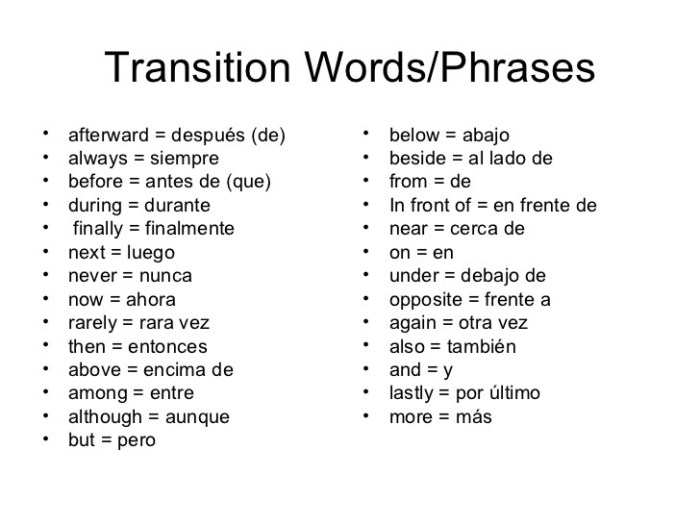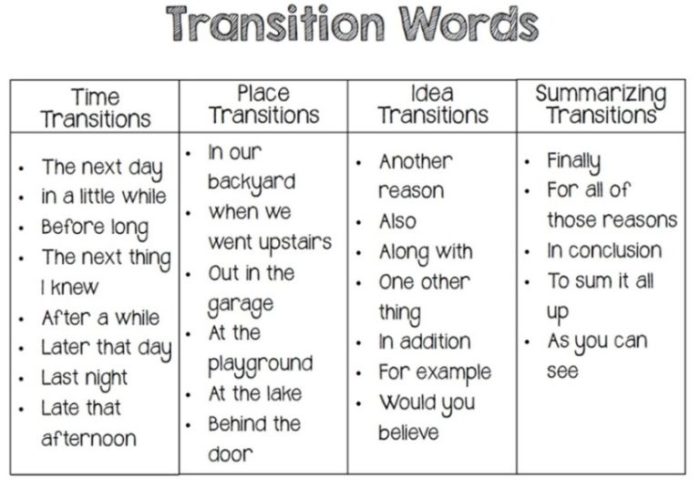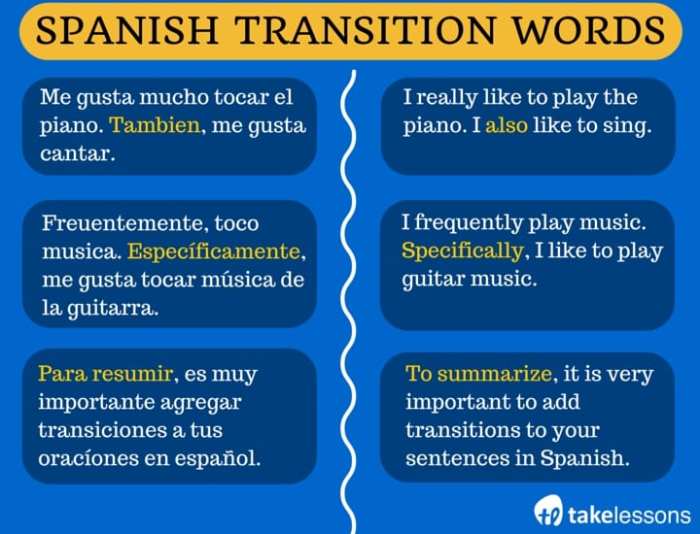Palabras de transicion en español, or Spanish transition words, play a pivotal role in the effective communication of ideas and thoughts. They serve as linguistic bridges, seamlessly connecting sentences, paragraphs, and sections, ensuring a smooth and logical flow of information.
This comprehensive guide delves into the diverse types, usage, benefits, and advanced techniques of employing Spanish transition words, empowering learners to master this essential aspect of the language.
Spanish transition words encompass a wide range, including those that express addition (y, además), contrast (pero, sin embargo), cause and effect (por lo tanto, por consiguiente), and many more. Each type serves a specific function, adding nuance and clarity to written and spoken communication.
Types of Spanish Transition Words

Spanish transition words are essential for creating coherent and cohesive writing and speech. They help to connect ideas, indicate relationships between sentences, and guide the reader or listener through the text.
There are many different types of Spanish transition words, each with its own specific function. Some of the most common types include:
- Addition:These words add information to the previous sentence, such as y(and), además(moreover), and también(also).
- Contrast:These words indicate a contrast or difference between two ideas, such as pero(but), sin embargo(however), and no obstante(nevertheless).
- Cause and effect:These words show a cause-and-effect relationship between two events, such as porque(because), por lo tanto(therefore), and así que(so).
- Exemplification:These words introduce an example to support the previous statement, such as por ejemplo(for example), como(as), and a saber(namely).
- Conclusion:These words signal the end of a thought or argument, such as por último(finally), en conclusión(in conclusion), and para terminar(to conclude).
Examples of Spanish Transition Words in Use

| Type of Transition Word | Spanish Transition Word | English Translation | Example Sentence |
|---|---|---|---|
| Addition | y | and | Me gusta leer y escribir. (I like to read and write.) |
| Contrast | pero | but | Me gusta leer, pero no me gusta escribir. (I like to read, but I don’t like to write.) |
| Cause and effect | porque | because | Me gusta leer porque me relaja. (I like to read because it relaxes me.) |
| Exemplification | por ejemplo | for example | Hay muchos tipos de libros, por ejemplo, novelas, cuentos y poemas. (There are many types of books, for example, novels, short stories, and poems.) |
| Conclusion | por último | finally | Por último, quiero decir que leer es una actividad muy beneficiosa. (Finally, I want to say that reading is a very beneficial activity.) |
Benefits of Using Spanish Transition Words: Palabras De Transicion En Español

Using Spanish transition words offers several benefits for both writing and speaking:
- Clarity:Transition words help to make your writing and speech more clear and easy to understand by providing a logical flow of ideas.
- Coherence:Transition words help to connect your ideas and make your writing and speech more cohesive.
- Flow:Transition words help to create a smooth flow in your writing and speech, making it easier for readers or listeners to follow your train of thought.
Common Mistakes in Using Spanish Transition Words
There are some common mistakes that people make when using Spanish transition words. These include:
- Using the wrong transition word:It is important to choose the right transition word for the specific relationship you want to convey between your ideas.
- Using too many transition words:Using too many transition words can make your writing or speech sound choppy and disjointed.
- Using transition words incorrectly:It is important to use transition words correctly in order to avoid confusion.
Advanced Techniques for Using Spanish Transition Words
There are several advanced techniques that you can use to effectively incorporate Spanish transition words into your writing and speech. These include:
- Using multiple transition words in a single sentence:You can use multiple transition words in a single sentence to create a more complex and nuanced relationship between your ideas.
- Creating smooth transitions between different sections of a text:You can use transition words to create smooth transitions between different sections of a text, such as between paragraphs or sections.
Q&A
What are the most common types of Spanish transition words?
The most common types include those that express addition (y, además), contrast (pero, sin embargo), cause and effect (por lo tanto, por consiguiente), and time (entonces, después).
How can I improve my use of Spanish transition words?
Practice regularly, study different types and their usage, and pay attention to how native speakers use them in context.
Are there any advanced techniques for using Spanish transition words?
Yes, advanced techniques include using multiple transition words in a single sentence, creating smooth transitions between different sections of a text, and employing them to signal discourse structure.